Information Extraction
Information extraction is the process of automatically extracting structured information from unstructured text data.
Papers and Code
Thought Communication in Multiagent Collaboration
Oct 23, 2025Natural language has long enabled human cooperation, but its lossy, ambiguous, and indirect nature limits the potential of collective intelligence. While machines are not subject to these constraints, most LLM-based multi-agent systems still rely solely on natural language, exchanging tokens or their embeddings. To go beyond language, we introduce a new paradigm, thought communication, which enables agents to interact directly mind-to-mind, akin to telepathy. To uncover these latent thoughts in a principled way, we formalize the process as a general latent variable model, where agent states are generated by an unknown function of underlying thoughts. We prove that, in a nonparametric setting without auxiliary information, both shared and private latent thoughts between any pair of agents can be identified. Moreover, the global structure of thought sharing, including which agents share which thoughts and how these relationships are structured, can also be recovered with theoretical guarantees. Guided by the established theory, we develop a framework that extracts latent thoughts from all agents prior to communication and assigns each agent the relevant thoughts, along with their sharing patterns. This paradigm naturally extends beyond LLMs to all modalities, as most observational data arise from hidden generative processes. Experiments on both synthetic and real-world benchmarks validate the theory and demonstrate the collaborative advantages of thought communication. We hope this work illuminates the potential of leveraging the hidden world, as many challenges remain unsolvable through surface-level observation alone, regardless of compute or data scale.
PointMapPolicy: Structured Point Cloud Processing for Multi-Modal Imitation Learning
Oct 23, 2025



Robotic manipulation systems benefit from complementary sensing modalities, where each provides unique environmental information. Point clouds capture detailed geometric structure, while RGB images provide rich semantic context. Current point cloud methods struggle to capture fine-grained detail, especially for complex tasks, which RGB methods lack geometric awareness, which hinders their precision and generalization. We introduce PointMapPolicy, a novel approach that conditions diffusion policies on structured grids of points without downsampling. The resulting data type makes it easier to extract shape and spatial relationships from observations, and can be transformed between reference frames. Yet due to their structure in a regular grid, we enable the use of established computer vision techniques directly to 3D data. Using xLSTM as a backbone, our model efficiently fuses the point maps with RGB data for enhanced multi-modal perception. Through extensive experiments on the RoboCasa and CALVIN benchmarks and real robot evaluations, we demonstrate that our method achieves state-of-the-art performance across diverse manipulation tasks. The overview and demos are available on our project page: https://point-map.github.io/Point-Map/
Prescribed Performance Control of Deformable Object Manipulation in Spatial Latent Space
Oct 16, 2025Manipulating three-dimensional (3D) deformable objects presents significant challenges for robotic systems due to their infinite-dimensional state space and complex deformable dynamics. This paper proposes a novel model-free approach for shape control with constraints imposed on key points. Unlike existing methods that rely on feature dimensionality reduction, the proposed controller leverages the coordinates of key points as the feature vector, which are extracted from the deformable object's point cloud using deep learning methods. This approach not only reduces the dimensionality of the feature space but also retains the spatial information of the object. By extracting key points, the manipulation of deformable objects is simplified into a visual servoing problem, where the shape dynamics are described using a deformation Jacobian matrix. To enhance control accuracy, a prescribed performance control method is developed by integrating barrier Lyapunov functions (BLF) to enforce constraints on the key points. The stability of the closed-loop system is rigorously analyzed and verified using the Lyapunov method. Experimental results further demonstrate the effectiveness and robustness of the proposed method.
Two-stream network-driven vision-based tactile sensor for object feature extraction and fusion perception
Oct 14, 2025Tactile perception is crucial for embodied intelligent robots to recognize objects. Vision-based tactile sensors extract object physical attributes multidimensionally using high spatial resolution; however, this process generates abundant redundant information. Furthermore, single-dimensional extraction, lacking effective fusion, fails to fully characterize object attributes. These challenges hinder the improvement of recognition accuracy. To address this issue, this study introduces a two-stream network feature extraction and fusion perception strategy for vision-based tactile systems. This strategy employs a distributed approach to extract internal and external object features. It obtains depth map information through three-dimensional reconstruction while simultaneously acquiring hardness information by measuring contact force data. After extracting features with a convolutional neural network (CNN), weighted fusion is applied to create a more informative and effective feature representation. In standard tests on objects of varying shapes and hardness, the force prediction error is 0.06 N (within a 12 N range). Hardness recognition accuracy reaches 98.0%, and shape recognition accuracy reaches 93.75%. With fusion algorithms, object recognition accuracy in actual grasping scenarios exceeds 98.5%. Focused on object physical attributes perception, this method enhances the artificial tactile system ability to transition from perception to cognition, enabling its use in embodied perception applications.
Dimensionality Reduction for Remote Sensing Data Analysis: A Systematic Review of Methods and Applications
Oct 21, 2025Earth observation involves collecting, analyzing, and processing an ever-growing mass of data. Automatically harvesting information is crucial for addressing significant societal, economic, and environmental challenges, ranging from environmental monitoring to urban planning and disaster management. However, the high dimensionality of these data poses challenges in terms of sparsity, inefficiency, and the curse of dimensionality, which limits the effectiveness of machine learning models. Dimensionality reduction (DR) techniques, specifically feature extraction, address these challenges by preserving essential data properties while reducing complexity and enhancing tasks such as data compression, cleaning, fusion, visualization, anomaly detection, and prediction. This review provides a handbook for leveraging DR across the RS data value chain and identifies opportunities for under-explored DR algorithms and their application in future research.
Domain-Adapted Pre-trained Language Models for Implicit Information Extraction in Crash Narratives
Oct 10, 2025



Free-text crash narratives recorded in real-world crash databases have been shown to play a significant role in improving traffic safety. However, large-scale analyses remain difficult to implement as there are no documented tools that can batch process the unstructured, non standardized text content written by various authors with diverse experience and attention to detail. In recent years, Transformer-based pre-trained language models (PLMs), such as Bidirectional Encoder Representations from Transformers (BERT) and large language models (LLMs), have demonstrated strong capabilities across various natural language processing tasks. These models can extract explicit facts from crash narratives, but their performance declines on inference-heavy tasks in, for example, Crash Type identification, which can involve nearly 100 categories. Moreover, relying on closed LLMs through external APIs raises privacy concerns for sensitive crash data. Additionally, these black-box tools often underperform due to limited domain knowledge. Motivated by these challenges, we study whether compact open-source PLMs can support reasoning-intensive extraction from crash narratives. We target two challenging objectives: 1) identifying the Manner of Collision for a crash, and 2) Crash Type for each vehicle involved in the crash event from real-world crash narratives. To bridge domain gaps, we apply fine-tuning techniques to inject task-specific knowledge to LLMs with Low-Rank Adaption (LoRA) and BERT. Experiments on the authoritative real-world dataset Crash Investigation Sampling System (CISS) demonstrate that our fine-tuned compact models outperform strong closed LLMs, such as GPT-4o, while requiring only minimal training resources. Further analysis reveals that the fine-tuned PLMs can capture richer narrative details and even correct some mislabeled annotations in the dataset.
Extracting latent representations from X-ray spectra. Classification, regression, and accretion signatures of Chandra sources
Oct 15, 2025The study of X-ray spectra is crucial to understanding the physical nature of astrophysical sources. Machine learning methods can extract compact and informative representations of data from large datasets. The Chandra Source Catalog (CSC) provides a rich archive of X-ray spectral data, which remains largely underexplored in this context. This work aims to develop a compact and physically meaningful representation of Chandra X-ray spectra using deep learning. To verify that the learned representation captures relevant information, we evaluate it through classification, regression, and interpretability analyses. We use a transformer-based autoencoder to compress X-ray spectra. The input spectra, drawn from the CSC, include only high-significance detections. Astrophysical source types and physical summary statistics are compiled from external catalogs. We evaluate the learned representation in terms of spectral reconstruction accuracy, clustering performance on 8 known astrophysical source classes, and correlation with physical quantities such as hardness ratios and hydrogen column density ($N_H$). The autoencoder accurately reconstructs spectra with 8 latent variables. Clustering in the latent space yields a balanced classification accuracy of $\sim$40% across the 8 source classes, increasing to $\sim$69% when restricted to AGNs and stellar-mass compact objects exclusively. Moreover, latent features correlate with non-linear combinations of spectral fluxes, suggesting that the compressed representation encodes physically relevant information. The proposed autoencoder-based pipeline is a powerful tool for the representation and interpretation of X-ray spectra, providing a compact latent space that supports both classification and the estimation of physical properties. This work demonstrates the potential of deep learning for spectral studies and uncovering new patterns in X-ray data.
C2T-ID: Converting Semantic Codebooks to Textual Document Identifiers for Generative Search
Oct 22, 2025
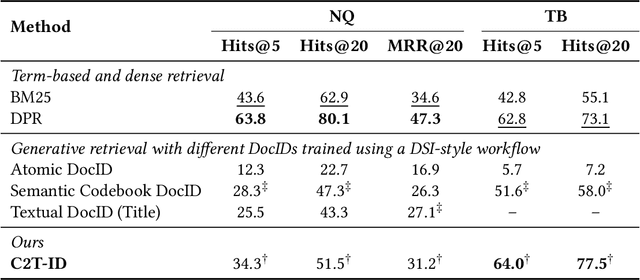


Designing document identifiers (docids) that carry rich semantic information while maintaining tractable search spaces is a important challenge in generative retrieval (GR). Popular codebook methods address this by building a hierarchical semantic tree and constraining generation to its child nodes, yet their numeric identifiers cannot leverage the large language model's pretrained natural language understanding. Conversely, using text as docid provides more semantic expressivity but inflates the decoding space, making the system brittle to early-step errors. To resolve this trade-off, we propose C2T-ID: (i) first construct semantic numerical docid via hierarchical clustering; (ii) then extract high-frequency metadata keywords and iteratively replace each numeric label with its cluster's top-K keywords; and (iii) an optional two-level semantic smoothing step further enhances the fluency of C2T-ID. Experiments on Natural Questions and Taobao's product search demonstrate that C2T-ID significantly outperforms atomic, semantic codebook, and pure-text docid baselines, demonstrating its effectiveness in balancing semantic expressiveness with search space constraints.
Agentic Systems in Radiology: Design, Applications, Evaluation, and Challenges
Oct 10, 2025Building agents, systems that perceive and act upon their environment with a degree of autonomy, has long been a focus of AI research. This pursuit has recently become vastly more practical with the emergence of large language models (LLMs) capable of using natural language to integrate information, follow instructions, and perform forms of "reasoning" and planning across a wide range of tasks. With its multimodal data streams and orchestrated workflows spanning multiple systems, radiology is uniquely suited to benefit from agents that can adapt to context and automate repetitive yet complex tasks. In radiology, LLMs and their multimodal variants have already demonstrated promising performance for individual tasks such as information extraction and report summarization. However, using LLMs in isolation underutilizes their potential to support complex, multi-step workflows where decisions depend on evolving context from multiple information sources. Equipping LLMs with external tools and feedback mechanisms enables them to drive systems that exhibit a spectrum of autonomy, ranging from semi-automated workflows to more adaptive agents capable of managing complex processes. This review examines the design of such LLM-driven agentic systems, highlights key applications, discusses evaluation methods for planning and tool use, and outlines challenges such as error cascades, tool-use efficiency, and health IT integration.
Adaptive Decoding via Hierarchical Neural Information Gradients in Mouse Visual Tasks
Oct 10, 2025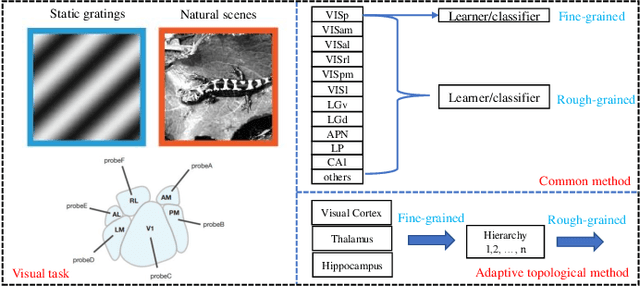
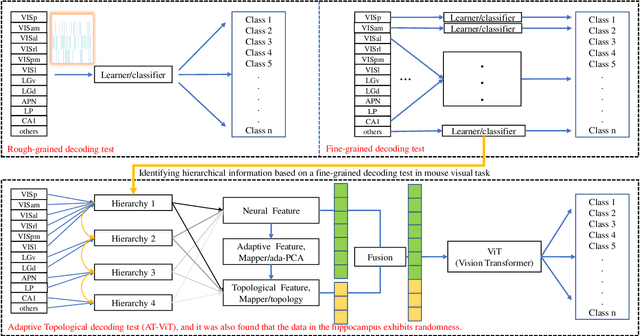
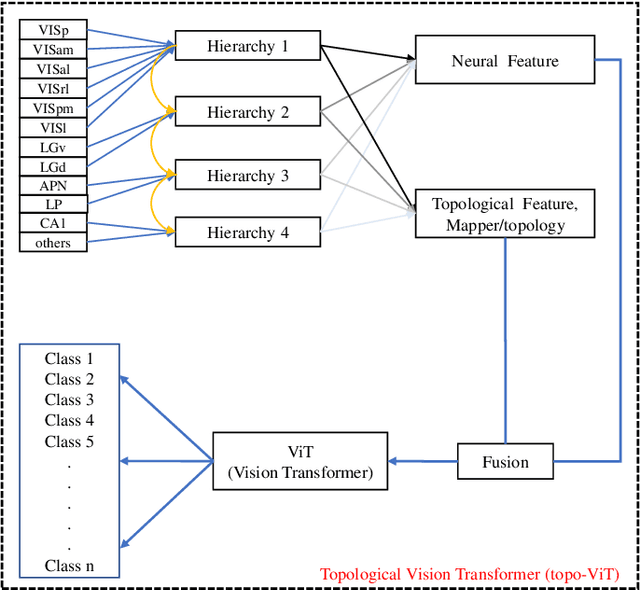
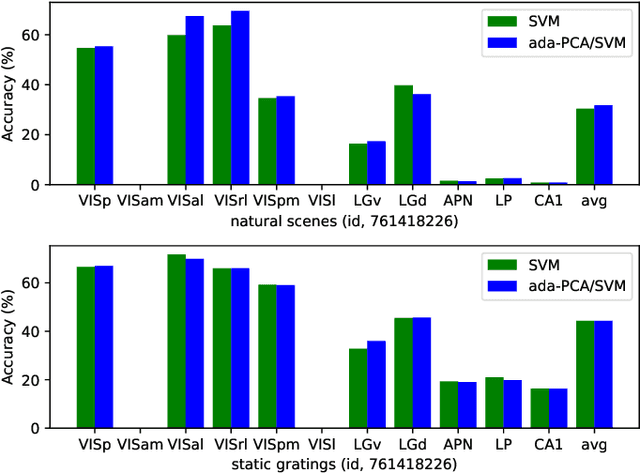
Understanding the encoding and decoding mechanisms of dynamic neural responses to different visual stimuli is an important topic in exploring how the brain represents visual information. Currently, hierarchically deep neural networks (DNNs) have played a significant role as tools for mining the core features of complex data. However, most methods often overlook the dynamic generation process of neural data, such as hierarchical brain's visual data, within the brain's structure. In the decoding of brain's visual data, two main paradigms are 'fine-grained decoding tests' and 'rough-grained decoding tests', which we define as focusing on a single brain region and studying the overall structure across multiple brain regions, respectively. In this paper, we mainly use the Visual Coding Neuropixel dataset from the Allen Brain Institute, and the hierarchical information extracted from some single brain regions (i.e., fine-grained decoding tests) is provided to the proposed method for studying the adaptive topological decoding between brain regions, called the Adaptive Topological Vision Transformer, or AT-ViT. In numerous experiments, the results reveal the importance of the proposed method in hierarchical networks in the visual tasks, and also validate the hypothesis that "the hierarchical information content in brain regions of the visual system can be quantified by decoding outcomes to reflect an information hierarchy." Among them, we found that neural data collected in the hippocampus can have a random decoding performance, and this negative impact on performance still holds significant scientific value.
 Add to Chrome
Add to Chrome Add to Firefox
Add to Firefox Add to Edge
Add to Edge